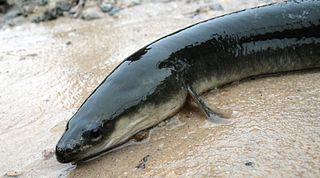
The American eel is a facultative catadromous fish found on the eastern coast of North America. Freshwater eels are fish belonging to the elopomorph superorder, a group of phylogenetically ancient teleosts. The American eel has a slender, snake-like body that is covered with a mucus layer, which makes the eel appear to be naked and slimy despite the presence of minute scales. A long dorsal fin runs from the middle of the back and is continuous with a similar ventral fin. Pelvic fins are absent, and relatively small pectoral fins can be found near the midline, followed by the head and gill covers. Variations exist in coloration, from olive green, brown shading to greenish-yellow and light gray or white on the belly. Eels from clear water are often lighter than those from dark, tannic acid streams.
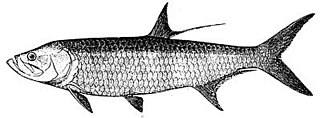
The Elopiformes are the order of ray-finned fish including the tarpons, tenpounders, and ladyfish, as well as a number of extinct types. They have a long fossil record, easily distinguished from other fishes by the presence of an additional set of bones in the throat.

The bonefish is the type species of the bonefish family (Albulidae), the only family in order Albuliformes.
The ballyhoo halfbeak or ballyhoo is a baitfish of the halfbeak family (Hemiramphidae). It is similar to the Balao halfbeak in most features. Ballyhoo are frequently used as cut bait and for trolling purposes by saltwater sportsmen. The fish is reported to have caused ciguatera poisoning in humans.

The Elopidae are a family of ray-finned fish containing a single living genus Elops. They are commonly known as ladyfish, skipjacks, jack-rashes, or tenpounders.

The ladyfish or tenpounder is a species of fish in the genus Elops, the only genus in the monotypic family Elopidae.

The superorder Elopomorpha contains a variety of types of fishes that range from typical silvery-colored species, such as the tarpons and ladyfishes of the Elopiformes and the bonefishes of the Albuliformes, to the long and slender, smooth-bodied eels of the Anguilliformes. The one characteristic uniting this group of fishes is they all have leptocephalus larvae, which are unique to the Elopomorpha. No other fishes have this type of larvae.

The blue runner, also known as the bluestripe jack, Egyptian scad, hardtail jack or hardnose, is a common species of moderately large marine fish classified in the jack family, Carangidae. The blue runner is distributed across the Atlantic Ocean, ranging from Brazil to Canada in the western Atlantic and from Angola to Great Britain including the Mediterranean in the east Atlantic. The blue runner is distinguished from similar species by several morphological features, including the extent of the upper jaw, gill raker count and lateral line scale counts. The blue runner is known to reach a maximum length of 70 cm and 5.05 kg in weight, but is much more common below 35 cm. The species inhabits both inshore and offshore environments, predominantly over reefs, however it is known to congregate around large, man-made, offshore structures such as oil platforms. Juveniles tend to inhabit shallower reef and lagoon waters, before moving to deeper waters as adults.

The Pacific ladyfish, also known as the Pacific tenpounder and Machete, is a species of ray-finned fish in the genus Elops, the only genus in the monotypic family Elopidae. The Pacific ladyfish can be found throughout the southwest U.S. and other areas in the Pacific Ocean.

The Hawaiian ladyfish, also known as the Hawaiian tenpounder or banana fish, is a species of ray-finned fish in the family Elopidae. It is sometimes referred to as the giant herring, though it is not closely related to the true herrings of the family Clupeidae. Its Hawaiian name is awa 'aua. It is native to the west central Pacific Ocean, and the current classification may in fact consist of several species.

The West African ladyfish is a species of ray-finned fish in the family Elopidae. It is native to the coastal waters of the eastern Atlantic Ocean, from Senegal to Angola. It is also known as the Guinean ladyfish. Some have been known to grow to 20 lb (9.1 kg).
The Senegalese ladyfish is a species of ray-finned fish in the family Elopidae, and is native to the coastal waters of the eastern Atlantic Ocean from Mauritania to the Democratic Republic of the Congo. It is often confused with the West African ladyfish, Elops lacerta, and can be distinguished only by the number of gill rakers on the lower part of the first gill arc, and the number of scales on the lateral line.
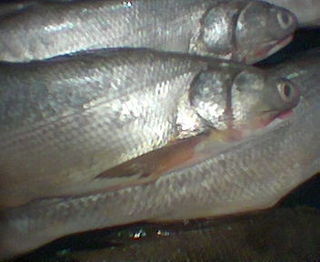
Elops machnata, the tenpounder, is a species of ray-finned fish in the family Elopidae in the order Elopiformes. This species is found in coastal regions of the Indian Ocean.

The Atlantic tarpon is a ray-finned fish that inhabits coastal waters, estuaries, lagoons, and rivers. It is also known as the silver king. It is found in the Atlantic Ocean, typically in tropical and subtropical regions, though it has been reported as far north as Nova Scotia and the Atlantic coast of southern France, and as far south as Argentina. As with all elopiformes, it spawns at sea. Its diet includes small fish and crustaceans.
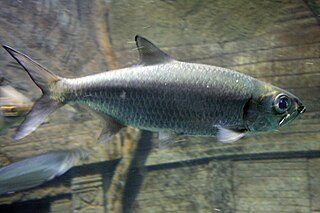
The Indo-Pacific tarpon, also known as the oxeye herring or simply herring due to its superficial resemblance to the true herrings, of which it is not a member, is the smaller of the two species of tarpon and lives in Indo-Pacific waters.
Albula glossodonta is a type of marine fish found in the Pacific Ocean. They grow up to 70 cm. Shortjaw bonefish are important to food security throughout the coastal Pacific where they are native as Pacific island communities depend on this fish for food. However, the species has become depleted throughout much of its range.

The Gulf menhaden is a small marine filter-feeding fish belonging to the family Clupeidae. The range of Gulf menhaden encompasses the entirety of the Gulf of Mexico nearshore waters, with the exception of the extreme eastern Yucatan and western Cuba. Evidence from morphology and DNA analyses suggest that the Gulf menhaden is the Gulf of Mexico complement to the Atlantic menhaden. Both species support large commercial reduction fisheries, with Gulf menhaden supporting the second largest fishery, by weight, in the United States.
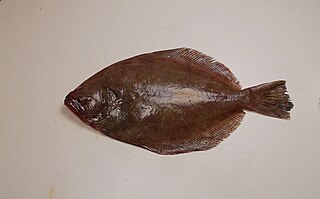
Paralichthys lethostigma, the southern flounder, is a species of large-tooth flounder native to the East Coast of the United States and the northern Gulf of Mexico. It is a popular sport fish and is the largest and most commercially valuable flounder in the western North Atlantic Ocean and Gulf of Mexico. It is a "left-eyed flounder", meaning the left side is pigmented and is the "up side".
Albula argentea, the silver sharpjaw bonefish, is a species of marine fish found in the tropical western Pacific Ocean. They grow up to 70 cm (28 in).
Albula oligolepis is a species of marine fish found in the Indo-West Pacific. It is known commonly as the smallscale bonefish. They grow up to 32 cm (13 in).














